Australia’s house prices are now in free fall
After six years of strong house price rises, Australia’s housing market is now cooling sharply. This is mainly due to the introduction of market-cooling measures, including stricter lending restrictions and the imposition of higher taxes on foreign investment in the housing market.
House prices in the country’s eight major cities fell by 7.7% during the year to Q1 2019 (-8.92% inflation-adjusted), in sharp contrast with the y-o-y rise of 2.2% a year earlier, based on figures from the Australian Bureau of Statistics (ABS). It was the fourth consecutive quarter of y-o-y house price decline and the biggest drop since data became available in Q1 2002.
Quarter-on-quarter, house prices fell by 3.07% (-3.07% inflation-adjusted) in Q1 2019.
However, the national figures conceal regional house price variations. Sydney saw the biggest decline, with the established house price index falling by 11% (-12.2% inflation-adjusted) during the year to Q1 2019, followed by Melbourne (-10.5%). Moderate to minimal house price falls were recorded in Darwin (-2.6%), Perth (-2.5%), Brisbane (-0.9%) and Canberra (-0.5%). On the other hand, house prices continue to rise modestly in Hobart (3.8%) and Adelaide (0.6%) during the year to Q1 2019.
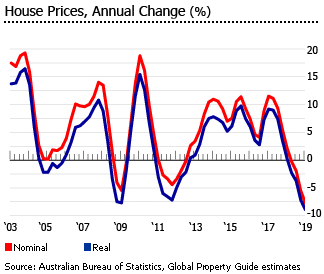
The mean price of residential dwellings in Australia was AU$636,900 (US$433,700) in Q1 2019, down by 7.4% from the same period last year, according to the ABS.
New South Wales, especially Sydney, has the most expensive housing in the country, with the mean house price at AU$806,800 (US$549,386) in Q1 2019, more than 25% above the national mean house price. In contrast, Tasmania has the cheapest housing in Australia, at a mean price of AU$412,700 (US$281,026) over the same period.
Both the demand and supply of homes are now falling. Purchases of new dwellings plummeted by 28.3% y-o-y during the first five months of 2019, according to ABS, and purchases of established dwellings fell by 13.9%.
In the secondary market, established dwelling purchases fell by 13.9% in January to May 2019 compared to last year, or a decline of 16.3% by value.
Dwelling approvals fell by 22.2% in the first half of 2019 compared to a year ago, according to ABS. Housing starts fell by 25% to just 46,267 units in Q1 2019 from a year earlier, according to the Housing Industry Association (HIA).
Australia’s slowing economy is not helping. In the first quarter of 2019, the economy expanded by 1.8% from a year earlier, the slowest expansion in more than five years, according to the ABS. The Reserve Bank of Australia (RBA), recently lowered its economic growth forecast for 2019 from 2.75% to 2.5%, and kept the official cash rate at a record low of 1% in August 2019, after cutting it by a cumulative 50 basis points in June and July, in an effort to bolster the economy.
Acquisition of residential real estate by foreign nationals and corporations is subject to FIRB approval. Foreigners are not allowed to buy an established (previously occupied) house. They may buy an unoccupied new dwelling, but only if the FIRB feels that the purchase will not add to the shortage of properties available to native Australians.
Outlook: house prices to fall further
After falling by 5.53% in 2018 (-7.19% inflation-adjusted) in 2018, Australian house prices are expected to continue falling this year.
- Fitch Ratings predicts that Australia will see the world’s biggest house price declines this year. It also added that the country has now hit a household debt-to-GDP ratio of 121% - a huge risk to the nation’s economy.
- CoreLogic’s head of research Cameron Kusher expects overall house price falls of 20% in Sydney and Melbourne.
- CBRE predicts house price falls of 15% to 20% in Sydney and 12% to 17% in Melbourne, with prices bottoming in 2019-20. For Brisbane and Perth, house prices in the next two years will be lower than their 2011 levels.
House prices in Australia surged 52.3% (35.6% inflation-adjusted) from 2011 to 2017. As such The Economist has warned that house prices in Sydney are overvalued by as much as 50%.

In an effort to address building risks caused by high household debt, the government introduced several market-cooling measures in recent years, including stricter lending restrictions and the imposition of higher taxes on foreign investment in the housing market.
Foreign property demand falling sharply
Australia´s house price surge can be partly attributed to foreign homebuyers, who have accounted for over 20% of property purchases every year.
However foreign property demand is now falling sharply, hit by tighter regulations both in Australia and in China, the largest source of foreign demand.
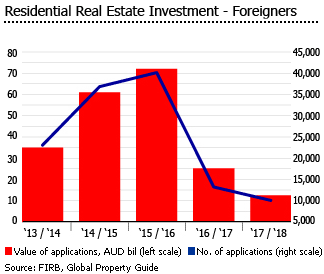
In 2018, foreign investment applications in Australian residential real estate fell to just 10,036, down from 13,198 in 2017 and 40,141 in 2016, according to the Foreign Investment Review Board (FIRB). The value of residential real estate investment by foreigners dropped by a half to AU$12.5 billion (US$8.5 billion).
Chinese buyers’ share of the total foreign real estate approvals in Australia remains the largest at 30% (AUD12.7 billion, or US$8.62 billion). However, it is a significant reduction from AUD31.9 billion (US$21.65 billion) two years ago.
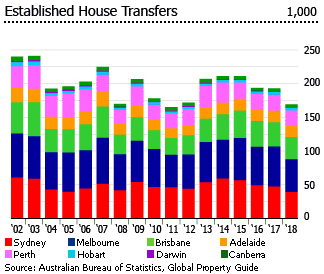
Juwai.com, a leading Chinese global property investment portal, reported that Chinese residential buying inquiries on Australian property plunged 20% in 2018 from a year earlier.
Why the slowdown in foreign purchases?
- New South Wales recently doubled its stamp duty charges for foreign buyers from 4% to 8%, and the annual land tax surcharge on foreign homeowners was raised from 0.75% to 2%
- Victoria raised its stamp duty for foreign buyers from 3% to 7%
- Queensland recently introduced a 3% stamp duty on foreign buyers
- The federal government introduced the so-called "ghost tax" on foreign investors in May 2017 - a AU$5,000 (US$3,700) annual charge on owners who leave their investment properties vacant or unavailable for rent for six months or more.
The effect of these measures was exacerbated by the introduction of capital controls in China in early 2017, effectively limiting the ability of Chinese citizens to get money out of the country, especially for property purchases abroad.

Victoria accounted for 46% of all residential purchases by foreigners last year, followed by New South Wales (23%) and Queensland (17%), according to the FIRB.
Housing affordability a major problem
Australia, specially its five major metropolitan areas, remains “severely unaffordable” in 2018, according to the 15th Annual Demographia International Housing Affordability Survey. The Demographia survey uses the Median Multiple to assess housing affordability in 309 metropolitan markets in Australia, Canada, China (Hong Kong), Ireland, Singapore, New Zealand, the United Kingdom, and the United States. Sydney was Australia’s least affordable housing market in 2018 and ranked third worst overall, with a Median Multiple of 11.7, followed by Melbourne (9.7), Adelaide (6.9), Brisbane (6.3), Perth (5.7). Housing affordability in Sydney has deteriorated by almost 70% over the past 14 years.

“Australia’s housing market is a source of vulnerability. Prices have more than doubled in real terms since the early 2000s and household debt has surged,” said the OECD. “The market has started to cool over the last year, with prices falling most notably in Melbourne and Sydney. So far, data point to a soft landing without substantial consequence for the overall economy. Nevertheless, risk of a hard landing remains.”
The country’s severe housing unaffordability, especially in Sydney, is partly due to urban consolidation policies which severely limit or even prohibit new housing construction on or beyond the urban fringe.
Residential construction activity is slowing sharply
Dwelling approvals fell by 22.2% to 86,788 units in the first half of 2019 compared to a year ago, according to ABS.
Queensland registered the biggest decline in dwelling approvals of 32% y-o-y in the first half of 2019, followed by Australian Capital Territory (-24.6%), Victoria (-22.5%), New South Wales (-20.9%), South Australia (-19.8%), Northern Territory (-15.2%) and Western Australia (-6.8%). Only Tasmania saw an annual rise in dwelling approvals of 6% in H1 2019.

The number of residential dwellings in Australia stood at 10.3 million in Q1 2019, up by 1.8% from a year earlier. New South Wales has 31% of dwelling stock, followed by Victoria (25.8%), Queensland (20%), and Western Australia (10.7%).
Residential construction to fall further
Overall building starts are expected to decline by 8% in 2019/20, pulled down by the slump in the residential market, according to BIS Oxford Economics.
The construction downturn is now hurting the major companies that operate in the industry. Ralan Group, one of Sydney’s major property developers, has gone into voluntary administration, leaving billions of dollars worth of apartment projects in doubt and $500 million owing to creditors. Also, cement manufacturer Adelaide Brighton has recently scrapped its interim dividend, in addition to a severe profit downgrade, sending its share price tumbling.
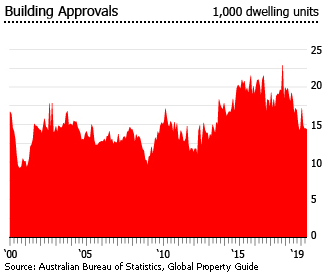
The anticipated continued decline in housing construction is expected to exacerbate the shortage of affordable housing, driving those at the bottom of the market to become renters instead of buying.
Australia has been under-building residential dwellings, for several reasons:
- Stringent urban planning policies and land use restrictions (called ´smart growth´, ´urban containment´, etc.). "An increase in state government zoning regulations is a significant factor driving up the cost of housing", said Reserve Bank of Australia Governor Glenn Stevens.
- Tax burdens on builders and developers. In New South Wales, government taxes and other charges are estimated to account for about 30% of the price of new houses.
- Due to the extended impact of the global credit crunch, some developers continue to struggle to secure finance.
Rental yields and residential rents are both rising
Rental yields in Australia continue to rise. In Q1 2019, the nationwide gross rental yields stood at 4.1%, up from 3.95% in the previous quarter and from 3.77% a year earlier, according to CoreLogic RP. Darwin has the highest rental yield across the country, at 6%.
In Q1 2019:
- Sydney has the lowest rental yields of 3.5%, up from 3.2% a year earlier
- In Melbourne, rental yields stood at 3.6%, sharply up from 31% in the same period last year
- In Brisbane, yields stood at 4.5%, up from 4.4% a year earlier
- In Adelaide, yields were unchanged at 4.4%
- In Perth, yields rose to 4.3%, from 3.9% in the previous year
- In Hobart, yields stood at 5.1%, unchanged from a year ago
- In Darwin, yields were 6%, up slightly from 5.9% a year earlier
- In Canberra, yields rose to 4.9%, from 4.7% a year earlier
During the year to Q1 2019, the median dwelling rent in Australia increased 0.4% to AU$436 (US$297) per month, according to CoreLogic. Hobart registered the largest annual rise in rental rates of 5.4% in Q1 2019, followed by Canberra (3.6%), Melbourne (2.1%), Perth (2.1%), Brisbane (1.4%) and Adelaide (1.2%). In contrast, residential rents fell Darwin (-5.7%) and Sydney (-3.1%) over the same period.
Interest rates are falling
The RBA kept the official cash rate unchanged at a record low of 1% in August 2019.
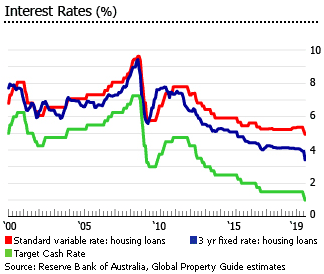
As a result, interest rates for housing loans have been falling:
- The average standard variable interest rate was 4.94% in July 2019, down from 5.22% a year earlier.
- The average discounted variable interest rate for housing loans stood at 4.25% in July 2019, down from 4.51% a year ago.
- The three-year fixed interest rate for housing loans stood at 3.41%, down from 4.11% a year earlier.
Mortgage market continues to grow
The Australian mortgage market has grown from around 15% of GDP in the 1970s to 95.5% in 2018, thanks to low interest rates. Residential housing loans outstanding rose by 5% in 2018 to more than AU$1.8 trillion (US$1.23 trillion), according to the Reserve Bank of Australia.

Housing loans for owner-occupiers stood at AU$1.1 trillion (US$750 billion), up by 6.4% from a year earlier. Housing loans for investors rose by 0.7% y-o-y to AU$557.5 billion.
Lending standards eased
With house prices now falling, the Australian Prudential Regulation Authority (APRA) has recently announced the removal of its 30% cap on interest-only residential mortgage lending by authorized deposit-taking institutions (ADI), effective January 1, 2019. The supervisory benchmark was put in place in March 2017, in an effort to cool surging property prices.
Earlier in April 2018, the 10% temporary cap on investor credit growth, introduced in December 2014, was removed.
“APRA’s lending benchmarks on investor and interest-only lending were always intended to be temporary,” said APRA chairman Wayne Byres. “Both have now served their purpose of moderating higher risk lending and supporting a gradual strengthening of lending standards across the industry over a number of years.”
APRA also proposes to remove its 7% interest rate floor for mortgage serviceability assessments and allow ADIs to set their own minimum interest rate floor for use in serviceability assessments and utilise a revised interest rate buffer of at least 2.5% over the loan’s interest rate.
Slowing economic growth; record trade surplus
In the first quarter of 2019, Australia’s economy expanded by 1.8% compared to the same period last year, down from y-o-y growth of 2.3% in Q4 2018, according to the ABS - the slowest expansion in more than five years. The International Monetary Fund (IMF) projects real GDP growth of 2.1% this year, down from an average annual growth of 2.7% from 2010 to 2018.
The Australian dollar (AUD) depreciated by almost 15% against the US dollar in the past year, from AUD 1 = USD 0.8073 in January 2018, to AUD 1 = USD 0.6894 in July 2019, effectively offsetting its gains two years earlier.

The country’s trade surplus surged to AUD 8.04 billion (USD5.46 billion) in June 2019 – its 18th consecutive month of trade surplus and the largest surplus on record, according to the ABS. In the first half of 2019, the trade surplus increased sharply to AUD 34.17 billion (US$23.19 billion) – more than four times higher as compared to AUD 7.56 billion (US$5.13 billion) in H1 2018. This was mainly due to the rising prices of iron ore and LNG exports, along with a drop in imports of non-industrial transport equipment such as cars and bikes.
In June 2019, exports rose by 1% to AUD42.38 billion (USD28.77 billion), the highest level ever recorded, while imports fell by 4% to AUD35.63 billion (USD24.19 billion).
It seems that Australia is benefitting from the ongoing trade war between the US and China, as it is now exporting more to both nations. In June 2019, Australia’s exports to China surged 35% y-o-y, while exports to the US also increased 15%.

Unemployment was 5.1% in April 2019, down from 5.5% a year earlier, according to the ABS. There were about 703,900 unemployed persons in Australia in April 2019, down by 3.7% from a year earlier.
Inflation stood at 1.6% in Q2 2019, up from 1.3% in the previous quarter but down from 2.1% a year earlier.
Sources:
- 6416.0 - Residential Property Price Indexes: Eight Capital Cities, Mar 2019 (Australian Bureau of Statistics): https://www.abs.gov.au/ausstats/[email protected]/mf/6416.0
- Australia to see world´s worst 2019 house price fall: report (ABC): https://www.abc.net.au/news/2019-01-16/australia-to-see-worst-fall-in-house-prices/10720406
- Housing market may bottom out over next year, Australian property experts say (The Guardian): https://www.theguardian.com/australia-news/2019/may/22/housing-market-may-bottom-out-over-next-year-australian-property-experts-say
- Residential Sector (CBRE): https://www.cbre.com.au/research-reports/Australia-Real-Estate-Market-Outlook-2019
- Foreign Investment Review Board Annual Report 2017-18 (FIRB): https://cdn.tspace.gov.au/uploads/sites/79/2019/02/FIRB-2017-18-Annual-Report-final-05-chap3.pdf
- Chinese investment in Australia is down 36%. It’s time for a more balanced debate about the national interest (The Conversation): http://theconversation.com/chinese-investment-in-australia-is-down-36-its-time-for-a-more-balanced-debate-about-the-national-interest-114984
- Chinese investment in Australian property to stay strong in 2019 as buyers look to ‘grab a bargain’ (Elite Agent): https://eliteagent.com/chinese-investment-in-australian-property-to-stay-strong-in-2019-as-buyers-look-to-grab-a-bargain/
- 15th Annual Demographia International Housing Affordability Survey: 2019 (Demographia): http://www.demographia.com/dhi.pdf
- APRA scraps interest-only cap (Mortgage Business): https://www.mortgagebusiness.com.au/breaking-news/12976-apra-scraps-interest-only-cap
- APRA finalises mortgage lending reforms (Mortgage Business): https://www.mortgagebusiness.com.au/breaking-news/13586-apra-finalises-mortgage-lending-reforms
- Rents Across Australia Rise Over The First Quarter Of 2019 (CoreLogic): https://www.corelogic.com.au/news/rents-across-australia-rise-over-first-quarter-2019
- 8731.0 - Building Approvals, Australia, Jun 2019 (Australian Bureau of Statistics): https://www.abs.gov.au/ausstats/[email protected]/mf/8731.0
- Dwelling Unit Commencements (Housing Industry Association): https://hia.com.au/-/media/HIA-Website/Files/IndustryBusiness/Economic/discussion-papers/dwelling-unit-commencements-australia.ashx?la=en&hash=4AD6DADE198DBD09BEF06FED123DDB4A442D80A4
- Building slowdown to hit bottom (The Australian Financial Review): https://www.afr.com/property/residential/building-slowdown-to-hit-bottom-20190726-p52b3w
- Property developer Ralan Group collapses, as construction slump hits Adelaide Brighton´s profits (ABC): https://www.abc.net.au/news/2019-07-31/construction-slump-hits-profits-adelaide-brighton-ralan-group/11369548
- Reserve Bank ´prepared to do unconventional things´ as economic outlook worsens (ABC): https://www.abc.net.au/news/2019-08-09/reserve-bank-cuts-economic-forecasts-again/11399576
- World Economic Outlook Database (International Monetary Fund): https://www.imf.org/external/pubs/ft/weo/2019/01/weodata/index.aspx
- Australia Balance of Trade (Trading Economics): https://tradingeconomics.com/australia/balance-of-trade
- Trade surplus record papers over Australia´s worrying domestic economic trends (ABC): https://www.abc.net.au/news/2019-08-06/trade-surplus-record-masks-grim-economic-trends/11387872
- Trend unemployment rate steady at 5.1% (Australian Bureau of Statistics): https://www.abs.gov.au/ausstats/[email protected]/lookup/6202.0Media%20Release1Apr%202019
- Reserve Bank of Australia holds fire on third-straight cash rate cut (The West Australian): https://thewest.com.au/business/your-money/reserve-bank-of-australia-holds-fire-on-third-straight-cash-rate-cut-ng-b881283529z